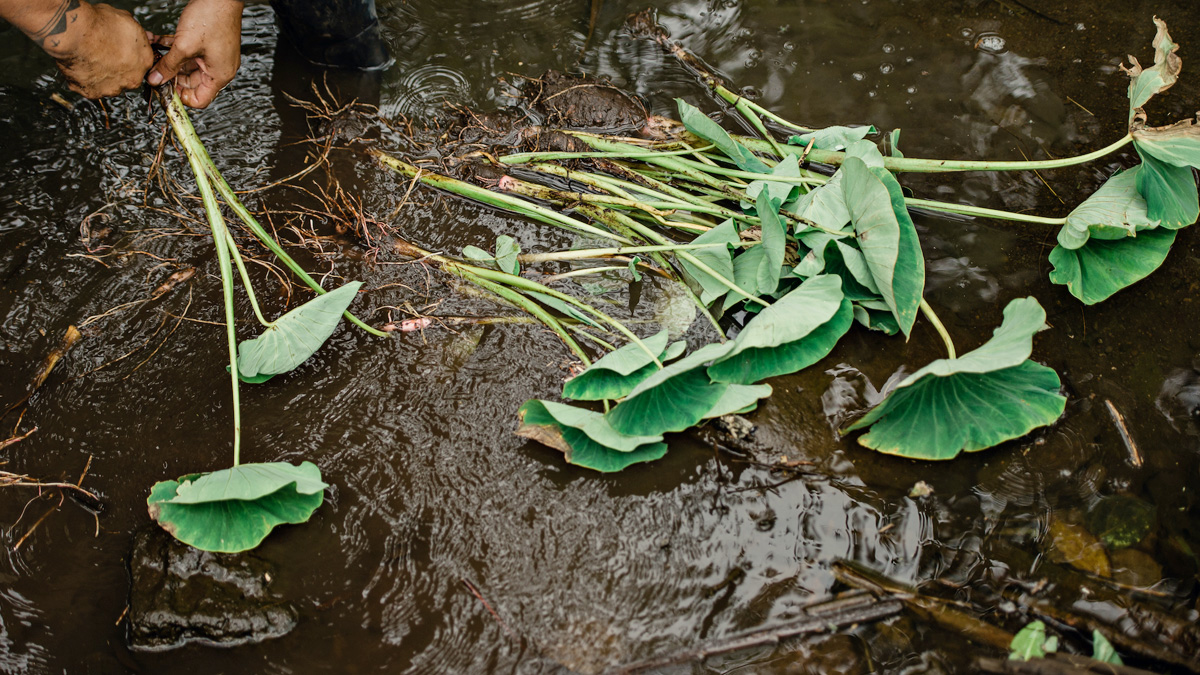More than just a staple food, kalo is a source of cultural and spiritual nourishment and identity.
In Hawaiian legends, nature is also family. In the Hawaiian creation story, Papahānaumoku (earth mother) and Wākea (sky father) created the islands of Hawaiʻi. Papa became pregnant and gave birth to a stillborn son named Hāloanakalaukapalili. He was buried and from his body grew a kalo plant. When Papa gave birth to a second child, a healthy baby boy, she named him Hāloa (everlasting breath) in honor of his older brother, kalo. Hawaiians are descendants of Hāloha, the first Hawaiian, and recognize the plant as an older brother.

Kalo, or taro, has been integral to the Hawaiian diet. Alongside mai‘a (banana), niu (coconut), and ‘ulu (breadfruit), kalo was one of the canoe plants, the original plants brought to the Hawaiian Islands by the first Polynesian settlers. It is estimated that they cultivated over 50 varieties.
The plant’s primary parts include the lau (leaf), hā (leaf stalks) and kalo (corm). The main hā is surrounded by smaller ʻoha, or offshoots. In ʻōlelo Hawaiʻi, the word ʻoha is connected to the word ʻohana, meaning family. Kalo that is ready to be harvested is known as the makua, or parent. The remaining ‘oha is removed and can be planted anew and the next generation of kalo continues. “Once you know the parts, you instantly relate,” Kapoi says. “It’s all family.”

Though the demands of working in a loʻi (kalo field) are physically taxing, Sam Kapoi and Daniel Anthony, who are both from Wai’anae, find its efforts worthwhile, both culturally and spiritually. “Put your feet in the dirt an’ feel ‘em,” Anthony says, scanning the lo‘i. “This is who we are.” Kapoi and Anthony consider kalo a form of food sovereignty and they want to bring kalo back as a staple Hawaiians eat on a regular basis.
Once kalo is cooked or steamed, it is ready for pounding. The two mainstay tools of the trade remain simple and traditional: a papa kuʻiʻai (food striking board) often fashioned from hard woods such as ‘ulu and kamani and a knobbed stone pounder called pōhaku ku‘i poi. The kalo is first pounded into pa‘iʻai, a thick, starchy, stretchy paste. Pounders must use both finesse and strength in their stroke. “It’s a push-pull movement,” Kapoi says.

Poi is then made by adding water to the paʻiʻai to a desired consistency. “I want to re-introduce Hawaiians to their original native food and remind them of their identity,” Kapoi says. “Hoʻolu i ka Lāhui. Grow the nation, in every way possible.”
Visit: kalobombs.com
Like: @KaloBombs
Follow: @KaloBombs
